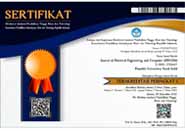S. Fernandez, C. Prihantoro, and A. Kharisma Hidayah, “Implementasi Weighted Product Pada Pemilihan Dosen Terbaik Di Universitas Muhammadiyah Bengkulu,” Pseudocode, vol. 8, no. 2, pp. 126–133, 2021.
R. Nur Annisa, M. Ugiarto, K. Gunung Kelua Samarinda, and K. Timur, “SISTEM INVENTARIS SARANA DAN PRASARANA DI FAKULTAS ILMU KOMPUTER DAN TEKNOLOGI INFORMASI UNIVERSITAS MULAWARMAN,” Prosiding Seminar Ilmu Komputer dan Teknologi Informasi, vol. 2, no. 1, 2017, [Online]. Available: www.bsnp-indonesia.org/id/wp-
A. Srirahyu and F. Suryani, “Implementasi Algoritma Sequential Search Pada Aplikasi Ensiklopedia Dermatologi Berbasis Mobile,” INFOKES, vol. 11, no. 1, 2021.
A. Muhazir, M. Fakhriza, and E. Sutejo, “Implementasi Metode Sequential Dalam Pencarian Pendistribusian Barang Pada Cargo Integration Sistem,” Jurnal & Penelitian Teknik Informatika, vol. 2, no. 2, 2017.
A. Sonita and M. Sari, “IMPLEMENTASI ALGORITMA SEQUENTIAL SEARCHING UNTUK PENCARIAN NOMOR SURAT PADA SISTEM ARSIP ELEKTRONIK,” 2018. [Online]. Available: www.ejournal.unib.ac.id/index.php/pseudocode
Y. Rahmanto, J. Alfian, and R. Indra Borman, “Penerapan Algoritma Sequential Search pada Aplikasi Kamus Bahasa Ilmiah Tumbuhan 21,” 2021.
S. K. Dirjen et al., “Implementasi Sequential Search Pada Pencarian Data Tarif Aplikasi Perjalanan Dinas Karyawan PT Telkom Akses,” RESTI, vol. 3, no. 2, pp. 202–209, 2019.
C. Tri Lestari and F. Latifah, “Aplikasi Pencatatan Keuangan Pribadi Dengan Analisa SWOT Menggunakan Algoritma Sequential Search Berbasis Mobile,” JISAMAR, vol. 3, no. 2, 2019.
A. A. Rismayadi and L. Jamaliah, “IMPLEMENTASI ALGORITMA SEQUENTIAL SEARCHING PADA APLIKASI E-OFFICE,” 2019.
S. Informasi et al., “INFORMATION SYSTEMS OF SOUTH SULAWESI HEROES HISTORICAL LOCATION USING SEQUENTIAL SEARCH ALGORITHM BASED ON ANDROID,” 2020.
Y. Religia, “Analisis Algoritma Sequential Search Dan Binary Search Pada Big Data,” Pelita, vol. 14, no. 1, pp. 74–79, 2019.
M. Y. Fathoni, R. F. Waliulu, A. Susanto, and M. Nishom, “Perancangan Aplikasi Penjualan Berbasis Client Server Pada Kedai WKWK Kota Purwokerto Menggunakan Metode Prototype,” J. Inform., vol. 7, no. 1, pp. 49–54, 2022.
W. M. Ashour, R. Z. Muqat, A. B. Alqazzaz, and S. R. Abdelnabi, “Improve basic sequential algorithm scheme using ant colony algorithm,” IEEE 7th Palest. Int. Conf. Electr. Comput. Eng. PICECE 2019, 2019.
E. Mühendisli, “EEG İş aretlerinin Ard ı ş ı k İ leri Yönde Seçim Algoritmas ı ile Öznitelik Seçimi ve Farkl ı S ı n ı fland ı r ı c ı lar ile İ ncelenmesi Feature Selection and Analysis EEG Signals with Sequential Forward Selection Algorithm and Different Classifiers,” pp. 1–4, 2020.
C. Zhang and Y. Zu, “An efficient parallel high utility sequential pattern mining algorithm,” Proc. - 21st IEEE Int. Conf. High Perform. Comput. Commun. 17th IEEE Int. Conf. Smart City 5th IEEE Int. Conf. Data Sci. Syst. HPCC/SmartCity/DSS 2019, pp. 2798–2803, 2019.
S. Shahzad, "Learning from Experience: The Analysis of an Extreme Programming Process," 2009 Sixth International Conference on Information Technology: New Generations, Las Vegas, NV, USA, 2009, pp. 1405-1410, doi: 10.1109/ITNG.2009.299.
S. Shahzad, "Learning from Experience: The Analysis of an Extreme Programming Process," 2009 Sixth International Conference on Information Technology: New Generations, Las Vegas, NV, USA, 2009, pp. 1405-1410, doi: 10.1109/ITNG.2009.299.
V. Jovanovic, T. Murphy and A. Greca, "Use of extreme programming (XP) in teaching introductory programming," 32nd Annual Frontiers in Education, Boston, MA, USA, 2002, pp. F1G-, doi: 10.1109/FIE.2002.1158141.
P. Sharma and N. Hasteer, "Analysis of linear sequential and extreme programming development methodology for a gaming application," 2016 International Conference on Communication and Signal Processing (ICCSP), Melmaruvathur, India, 2016, pp. 1916-1920, doi: 10.1109/ICCSP.2016.7754505.
A. M. K. Cheng and P. Wu, "Work-in-Progress: Incorporating Deadline-Based Scheduling in Tasking Programming Model for Extreme-Scale Parallel Computing," 2018 IEEE Real-Time Systems Symposium (RTSS), Nashville, TN, USA, 2018, pp. 131-134, doi: 10.1109/RTSS.2018.00022.
L. Pan, "Designing an Extreme-Based Teaching Model for the First Programming Course," 2021 International Conference on Computational Science and Computational Intelligence (CSCI), Las Vegas, NV, USA, 2021, pp. 1091-1094, doi: 10.1109/CSCI54926.2021.00230.
L. Liu and Y. Lu, "Application of agile method in the enterprise website backstage management system: Practices for extreme programming," 2012 2nd International Conference on Consumer Electronics, Communications and Networks (CECNet), Yichang, China, 2012, pp. 2412-2415, doi: 10.1109/CECNet.2012.6201545.
J. Kivi, D. Haydon, J. Hayes, R. Schneider and G. Succi, "Extreme programming: a university team design experience," 2000 Canadian Conference on Electrical and Computer Engineering. Conference Proceedings. Navigating to a New Era (Cat. No.00TH8492), Halifax, NS, Canada, 2000, pp. 816-820 vol.2, doi: 10.1109/CCECE.2000.849579.
V. Jovanovic, T. Murphy and A. Greca, "Use of extreme programming (XP) in teaching introductory programming," 32nd Annual Frontiers in Education, Boston, MA, USA, 2002, pp. F1G-, doi: 10.1109/FIE.2002.1158141.
J. Choudhari and U. Suman, "Iterative Maintenance Life Cycle Using eXtreme Programming," 2010 International Conference on Advances in Recent Technologies in Communication and Computing, Kottayam, India, 2010, pp. 401-403, doi: 10.1109/ARTCom.2010.52.
S. Bryant, "Double Trouble: Mixing Qualitative and Quantitative Methods in the Study of eXtreme Programmers," 2004 IEEE Symposium on Visual Languages - Human Centric Computing, Rome, Italy, 2004, pp. 55-61, doi: 10.1109/VLHCC.2004.20.
H. Li and H. Wang, "A bi-level training approach based on extreme learning machine autoencoder for data classification," 2022 18th International Conference on Computational Intelligence and Security (CIS), Chengdu, China, 2022, pp. 171-175, doi: 10.1109/CIS58238.2022.00043.
C. A. Wellington, "Managing a project course using Extreme Programming," Proceedings Frontiers in Education 35th Annual Conference, Indianopolis, IN, USA, 2005, pp. T3G-1, doi: 10.1109/FIE.2005.1611948.
Z. Li-li, H. Lian-feng and S. Qin-ying, "Research on Requirement for High-quality Model of Extreme Programming," 2011 International Conference on Information Management, Innovation Management and Industrial Engineering, Shenzhen, China, 2011, pp. 518-522, doi: 10.1109/ICIII.2011.132.
A. Vihavainen and M. Luukkainen, "Results from a Three-Year Transition to the Extreme Apprenticeship Method," 2013 IEEE 13th International Conference on Advanced Learning Technologies, Beijing, China, 2013, pp. 336-340, doi: 10.1109/ICALT.2013.104.
 (Institut Teknologi Telkom Purwokerto)
(Institut Teknologi Telkom Purwokerto) 








